Paper Dreams by Master Hui 雄獅紮作技藝超群 名揚海外承傳後世
English 英: Samantha Ho · Chinese 中: Fiona Cho 曹逸雲
Photography: Mike Chan, Esther Anderson, Boyd Robertson, Leigh McKinnon
As Featured in 2025 Fête Chinoise Design Annual
In the skilled hands of Master Hui Ka Hung, paper transforms into vibrant, lifelike creations embodying Hong Kong’s cultural heritage.
Hong Kong is a fast-paced city filled with innovation and potential. Among its towering skyscrapers are streets alive with people rushing to their next destination. Beyond the urban chaos lie alleys steeped in history and tradition. It is here that artisans preserve Hong Kong’s cultural heritage through traditional skills passed down for generations. Among them is Master Hui Ka Hung, whose workshop, Hung C Lau, has become synonymous with the art of paper craft.
紮作技藝是一門歷史悠久的民間手藝,兼具歷史文化及藝術價值。紮作師傅以簡單的材料如竹篾、紗紙、色紙、絹布等,運用紮作技巧和繪畫筆功製作而成。紮作製成品常見於「紅事」即傳統節日慶典和民間宗教儀式包括花炮、花燈、舞獅等;及「白事」即傳統向先人敬拜的紙祭品,也稱為火燒紮作,用以在拜祭後燒給神明或祖先。
雖然紮作品非常普遍,然而,紮作行業在華人社會地位低微,不獲重視,加上面對內地廠房大量生產紮作品的競爭,令香港本地紮作行業不斷萎縮,年輕人亦多不願入行。
Master Hui has devoted nearly 40 years to this intricate form, despite being barely 50 years old. As a child, he grew up immersed in his family’s martial arts school, where lion heads were essential to performances that blended artistry with physical skill. These headpieces—crafted from bamboo and paper—were treated as treasures, carefully stored after each use to prevent damage. Each time one was locked away, Hui’s fascination grew stronger. “To me, the lion head is very mysterious,” he says. “All I want to do is touch and explore it.”
An autodidact, Hui created his first lion head at age 11. Brimming with youthful pride, he presented his creation to established masters, hoping to impress them and make a sale. However, his work fell short of their standards—he wasn’t ready yet. One of them, recognizing his potential, offered an apprenticeship that would shape his future. Over the next 13 years, Hui honed his skills under the guidance of these experienced artisans. Using bamboo splints, paper, paste and determination, Hui mastered an ancient tradition that continues to captivate and inspire.
直至 2017 年,為了加強對非物質文化遺產的保護,香港政府公布了首份《香港非物質文化遺產代表作名錄》*。該名錄包括十個已列入國家級非遺代表性項目名錄的本地項目,以及在完成公眾諮詢後獲推薦納入香港非遺代表作名錄的十個項目,其中便包括紮作技藝。名錄公布後,這種傳統文化藝術才逐漸受到大眾關注,並從藝術品創作的角度為行業注入新的生命力。
「雄獅樓」是香港少有專做獅頭及傳統紙紮品的工作坊,創辦人許嘉雄師傅雖然只有 47 歲,但已入行超過三十年,手藝早已揚名國際。出生於武館家庭的許師傅,自小見證一到傳統節慶如農曆新年及神誕,武館便會舞龍、舞獅、舞麒麟。許師傅自幼獨愛舞獅,八十年代一頭「獅」的價值超過三萬港元,因此許師傅的父親會特製一個大木箱把「獅」鎖住,不讓人輕易觸摸。許師傅惟有在別人丢棄獅頭後,或拿舊獅頭來武館修補時,才有機會觸摸及研究製作技巧。
But what exactly is paper craft?
Many people associate it with simple arts-and-crafts projects involving scissors, glue and construction paper—ephemeral creations destined for storage or disposal. For those in Hong Kong or of Chinese descent, however, this art form plays a recurring role in life but is often overlooked. Most would describe it as objects burned as offerings for ancestors or gifts to the deceased. While this is true, it also includes elaborate decorations used during festivals and celebrations—an art form often underestimated.
“To me,” Hui says, “paper craft is full of infinite possibilities,” redefining what this ancient tradition can achieve.
十一歲那年,許師傅靠自學完成人生第一個獅頭,並將成品拿去一間國貨公司兜售。雖然那簡陋的「獅頭」不獲青睞,但他沒有因此氣餒,拿著「獅頭」一路逐間商舖去問人家是否有興趣購入他自製的獅頭,當然乏人問津。因為當時沒有學紮「獅頭」的地方,他後來在西環的一家紙紮店當學徒,每天製作殯儀用的紮作祭品。紮作的基本功就在這裡穩固地打下根基,一做便是十三年,直至創辦「雄獅樓」。
「俗語說:『多隻香爐多隻鬼』(意即多一個人入行就會把利益分薄),當年的師傅都不願意將秘訣技巧傳授徒弟。我都是從旁偷師自學,不像現今的學生,有師傅教導都不願意學。而且以前很難買到需用的材料,好像漿糊、紗紙都是獨特的。」許師傅娓娓道出當年學師的辛酸。
The process itself is meticulous: bamboo splints are bound into a sturdy structure; special paper is mounted with handmade paste; and the frame is brought to life with paint and intricate decorations. Over decades of dedication, Hui has mastered this traditional technique, transforming simple materials into vibrant creations that embody cultural heritage.
Although the tradition of paper crafting is common in Hong Kong, it has historically been viewed as working-class labour rather than artistic expression. Competition from mainland Chinese factories and a lack of young artisans entering the field threatened its survival—until paper crafting received official recognition in 2017.
「很多人有錯覺,以為紮作是夕陽工業,所以很少人肯入行。其實紮作品全年都有需求,例如農曆新年需要製作金龍、醒獅或者麒麟;二三月有神誕(天后、觀音)要製作花炮;四五月有端午的龍船、清明節的祭品;七月有盂蘭節(俗稱鬼節)的火燒祭品;八月中秋節的花燈;九月有重陽節的祭品等等。殯儀用的紮作火燒祭品更是全年無休。」許師博解釋社會對紮作品的需求。「現時內地將紮作品工業化,尤其是殯儀火葬用品,加上人工和廠房租金相宜,價錢便宜很多;相對來說,香港的貨品售價比較貴,但是品質、細緻度卻高很多。」
許師傅年青時沒有多想前途,唯一的興趣就是專注於如何製作一個栩栩如生的獅頭,曾經令父母非常擔心。他的岳母知道他是做紮作行業的,更是兩行眼淚直流,怕女兒要隨他捱窮,沒想到如今闖出一片新天地。
In that year, paper crafting was added to Hong Kong’s First Representative List of Intangible Cultural Heritage*. This recognition thrust the practice into the spotlight and named Hui its youngest master successor. With a laugh, Hui remarks: “It was okay when I was younger, but if I’m still the youngest master when I’m in my late 40s, that seems too long.” The designation brought renewed attention to this cultural treasure and allowed artisans like Hui to promote their work in innovative ways.
Hui admits that even with 365 days in a year, there isn’t enough time to fulfil all his orders. His work revolves around Hong Kong’s lunar calendar festivals. For Chinese New Year alone, ferocious lion heads and intricate dragons take months to prepare. Lion heads require about 10 days for Hui and his team to complete—a process that demands precise craftsmanship and teamwork.
「獅頭是很特別的,外行人看的是獅頭外貌,舞動的時候漂不漂亮,生不生動;內行人看的是內在美,內籠尺寸是否恰當,手工是否細緻、手感好不好,是否順滑,握手位會否容易被竹蔑扎刺;重量會否影響舞動時的發揮和平衡等。現在舞獅已不再是傳統武館比拼武術的競技,而是進化成一項運動,連小學也有舞獅班,所以輕巧靈活更為重要。」許嘉雄解釋。
紮作獅頭的步驟分為紮作、撲紙、寫色、裝飾。紮作獅頭要先開竹篾,竹蔑交疊之處用紗紙紮緊,再用漿糊黏實,造成獅頭的骨架結構。紮好後,就可以撲紙,將紙裁成小幅的長方形,用漿糊將它們逐層貼到骨架上:第一層是紗紙,再加一層布,再鋪一層紗紙,以增加獅頭的硬度。待晾乾後,便可以寫色,由師傅逐筆為獅頭上色及畫上花紋,再上光油。最後裝上各種配件,如眼珠、眼瞼布、生絲球、額頂鏡片、獅耳等,最後把整個獅口紮在獅頭上,便告完成。
「我製作的獅頭,『紮、撲、寫、裝』 四個程序都是我自己一手包辦,一氣呵成。這樣的獅子是有靈魂的,行內人能看出來。而獅頭的尺寸、內外設計都是靠經驗累積而成,我的設計是沒有草圖的,不過很有我自己的獨特風格。最初的設計都是模仿我所欣賞的前輩的獅頭造型,久了漸漸開始有自己的特色。這種風格是很難模仿的,例如:竹蔑削得油滑、手畫花紋像刀仔花、關刀很細緻活潑。舊式寫色會用磁油,但顏色選擇不多,我喜歡用廣告彩,貪其顏色選擇多而變化廣,不過仍然會用毛筆繪畫。最後,在上油的時候,我喜歡加上銀粉,當獅頭在陽光底下舞動的時候,會隨著跳躍舞動閃閃發光。通常製作一個獅頭需要十多天的時間,難度最高的是紮骨架的部分,全憑經驗。在這四至五年間,我已經製作超過一百個獅頭。每個獅頭都是一件藝術品,值得我們承傳成全下去。」 許師傅由衷地說。
As his workshop continues to thrive, Hui’s dedication to his craft extends to fostering a community of artisans who share his passion. Today, he works alongside family members, apprentices and students who assist in crafting stunning floral tributes for festivals or offerings for funerals. Renewed interest in this centuries-old practice has opened new business opportunities for him—both locally and internationally.
One notable project took him to Australia for the Golden Dragon Museum’s Dai Gum Loong dragon commission. Located in Bendigo—a historic city in central Victoria about 150 kilometres (93 miles) northwest of Melbourne—the museum serves as a living history of Chinese-Australian culture. It preserves artefacts and traditions dating back over 150 years to the Victorian gold rush when thousands of Chinese immigrants settled in Bendigo. These immigrants formed a vibrant community that contributed to local charities and cultural events like the annual Easter Festival.
許師傅的非凡手藝及作品不限於香港,更名揚海外如新加坡、馬來西亞、美國、南韓等地。最令許嘉雄感到驕傲的作品,是澳洲本迪戈市(Bendigo)金龍博物館委託他製作的「大金龍」。該市為昔日淘金勝地,有許多中國人在那裏居住,至今仍然保留許多華人文化和廟宇。
「最初收到金龍博物館的邀請時,我以為是詐騙!後來他們多次來函,我的侄子查看過後,知道是真的,更收到他們送來機票邀請我到博物館參觀。當我們飛抵金龍博物館後,發現館內的金龍全是香港師傅的紮作品。博物館有一個傳統,每隔五十年就會更新一次館內的金龍展品。館內的金龍有一百五十年、一百年和五十年的,那幾條金龍真的很美麗,栩栩如生,手工精巧高超,花紋細緻生動,一點也不像擁有百年歷史。
我以為自己的手藝也算不錯,但真是一山還有一山高。所以當金龍博物館從多位紮作師傅中揀選了我來製作新作品時,我實在有不能被比下去的志氣。」許師傅笑言為了增強氣勢,將金龍頭做大了一點,卻給博物館在運輸方面添了些麻煩。金龍頭太大,擠不進澳洲的航空公司贊助的機艙裡,需要另作安排。
Today, the museum houses some of the world’s most famous imperial dragons: Loong (1901), the oldest surviving dragon; Sun Loong (1970), its record-breaking successor; and now Dai Gum Loong (2019).
Initially sceptical—thinking it might be a scam—Hui refused the project at first but changed his mind after being invited to visit Bendigo himself. Walking through the museum’s chambers filled with Chinese artefacts and historic dragons inspired him deeply. “In the museum surrounded by all those Chinese artefacts—it felt sublime,” he says.
The commission came with strict requirements: every material had to be sourced from Hong Kong; techniques used by previous artisans had to be replicated; and 7,000 scales—each requiring a full day’s work—had to be crafted by hand with painstaking precision.
許嘉雄表示該條金龍頭高九呎,龍身長一百二十米,由七千多片「龍麟」組成。「一百五十年前的金龍龍麟片中銅圈的銅純度不夠高,所以有些生鏽。為了避免生鏽,我尋覓很久才找到純銅作麟片裝飾,材料費也因此加增不少。每一片龍麟都以手工縫製,我們三代人,包括父母、兄弟和子女及親戚合力製作,每人一天只能製作一片,用上七至八個月時間才完成,我們都感到非常高興。」許師傅回想當時情況仍舊歷歷在目。
四大金龍出巡之日,澳洲金龍博物館邀請許師傅與當地的州長、總督及市長一同參與「大金龍」的點睛儀式,可見他們對許師傅的重視和尊敬。許嘉雄坦言不能忘懷四條大金龍一起舞動的歷史性畫面,加上觀眾?的歡呼聲及讚美聲,讓他深深感受到那份愛,此生已經沒有遺憾。現時,該條百米「大金龍」已成為金龍博物館的珍藏品。五十年後,金龍博物館再次徵集新龍時,許師傅已超過九十歲,但他希望能將紮作手藝承傳,繼續讓香港師傅名揚海外。
“We use gouache watercolour paints because it gives the creation more depth,” Hui explains. “Then we go over it with lacquer mixed with silver powder—it creates a gleam when sunlight hits it.”
No detail was overlooked. Hui enlarged the dragon head to nine feet tall while ensuring it remained weightless during performances. When Dai Gum Loong debuted alongside its predecessors under Australia’s dry skies during Bendigo’s Easter Festival—it appeared both majestic and ethereal.“Being greeted by my predecessors’ dragons is like welcoming my dragon home,” he says.
Currently working on a prestigious new commission for HSBC—a global banking giant celebrating its 160th anniversary—Hui is crafting a pair of life-sized “stone lions” entirely from bamboo and paper. This latest project reflects his ambition to push boundaries while preserving deep traditions for future generations. “I’m aiming to create something that people will mistake for the real thing,” he says, with the confidence of a master in command of his art.
自紮作技藝被納入香港非物質文化遺產代表作名錄,紮作技藝地位提升,紮作師傅不再是「紙紮佬」而躍升成為「藝術家」。許嘉雄不時被邀請到不同機構、大學至小學講學,同時舉辦工作坊,也與政府合辦紮作技藝的「項目傳承培訓計劃」。他表示:「每年差不多有過百學生參加,但真正肯入行的只有二三人。當然藝術和天分也很重要的。其實國家級非遺代表性項目中,有幾項傳統技藝都有紮作藝術品作背景及裝飾,我很希望有一天紮作技藝也能躍升到國家級。我也有一個夢想,希望憑我的手藝能成為一代宗師,有很多優秀的徒弟,就像詠春大師葉問一樣。」
許師傅現時利用 Facebook 及Instagram 等社交媒體宣傳紮作藝術及舞獅運動,讓這些傳統藝術年輕化。近年,許嘉雄更不時與藝術家和商戶合作,除了製作傳統獅頭作品,更製作過多個裝置藝術品,例如仿真度極高的相機、室內聖誕裝飾、大銀行更邀請他製作以假亂真的銅獅子等。同時他也與本地設計師合作,把作品帶到美、日、韓等地展出。他希望有一天不再為口奔馳,可以開藝術展,將他超卓的紮作技藝以及作品公開展示。謹祝願許嘉雄師傅夢想成真,延續他的傳奇故事。
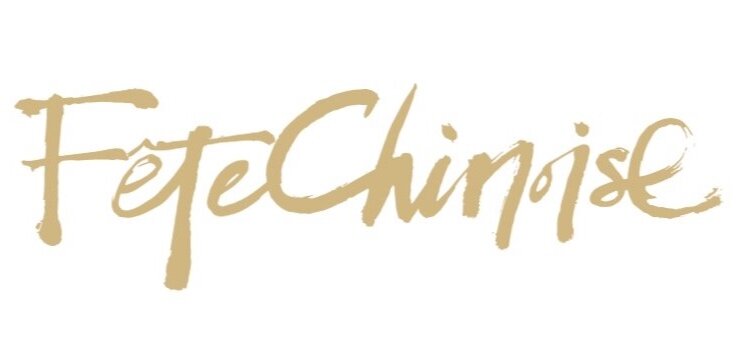

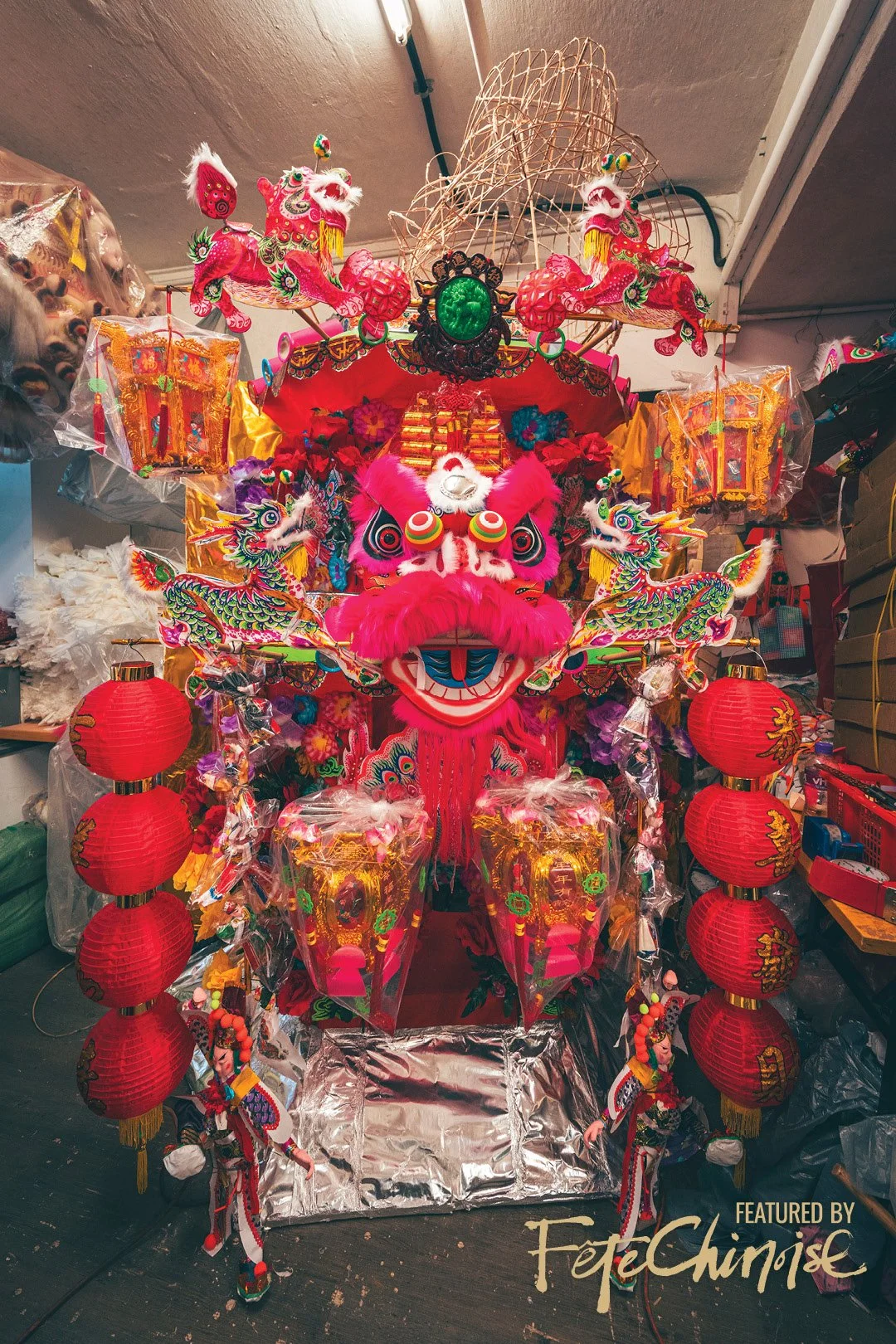
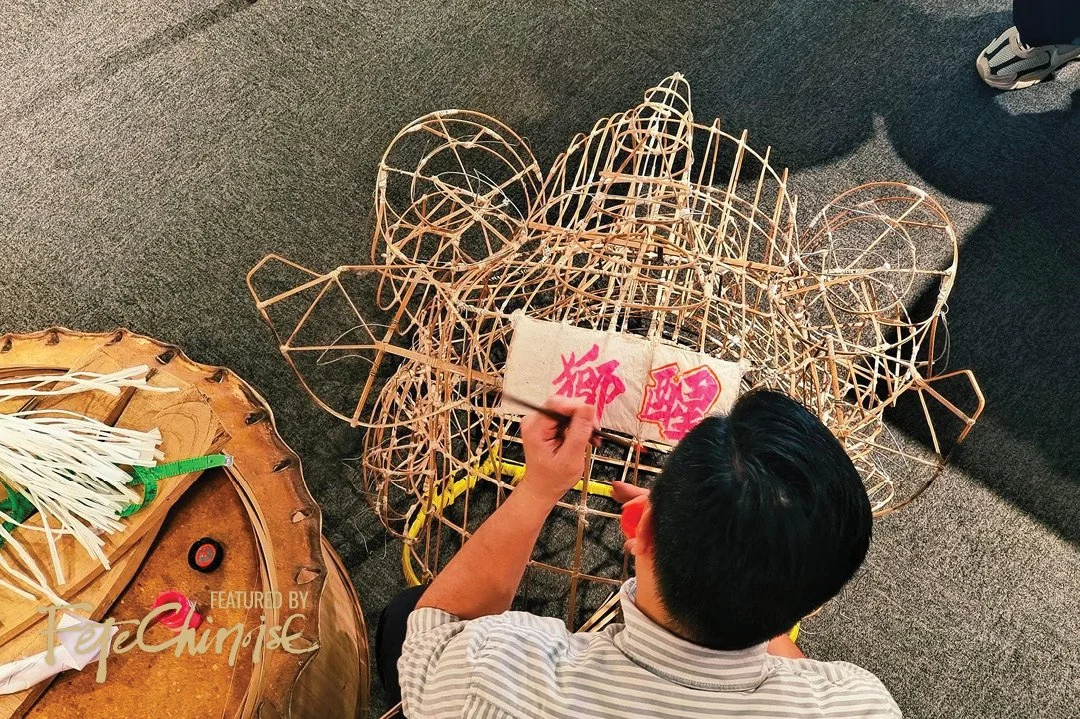
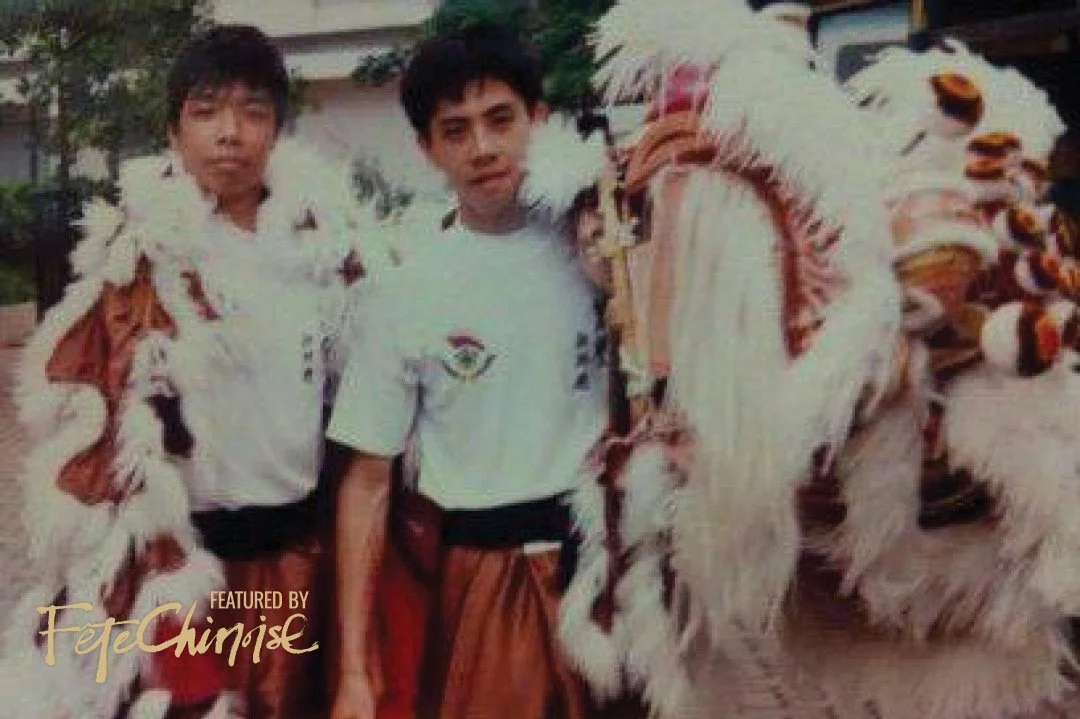
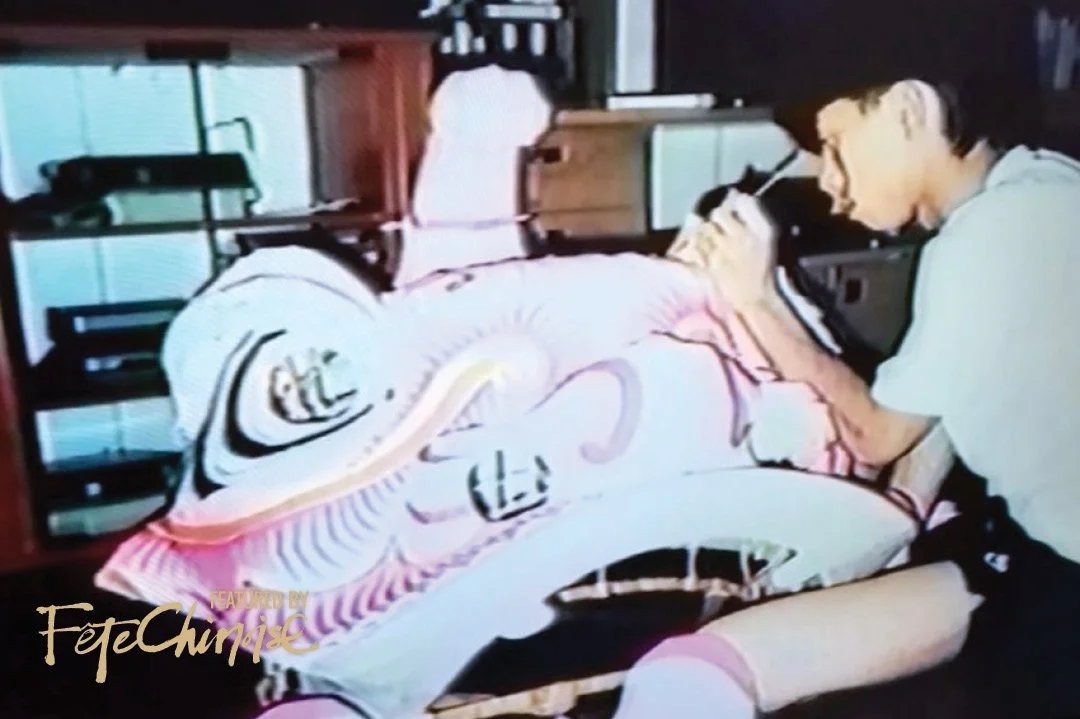
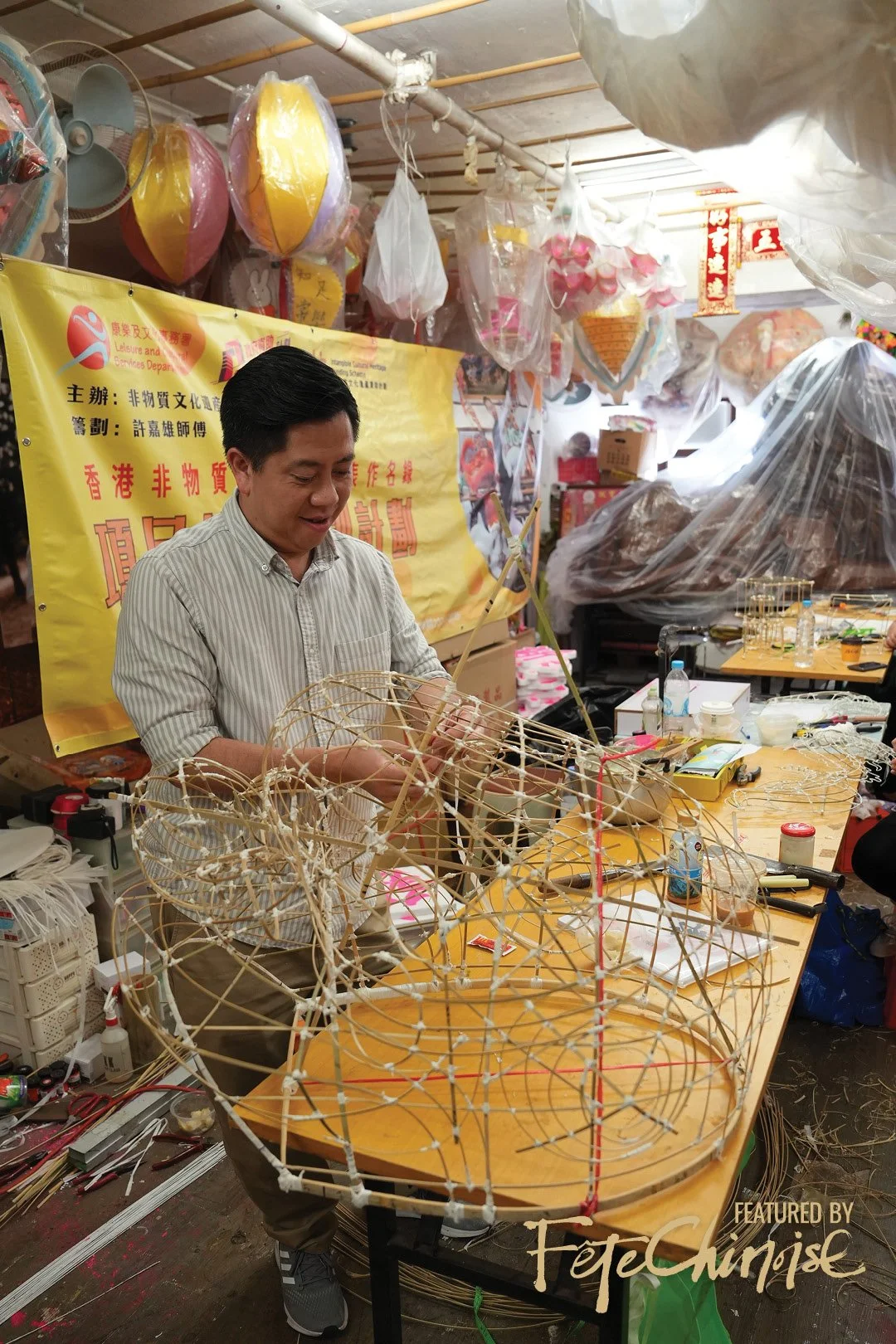
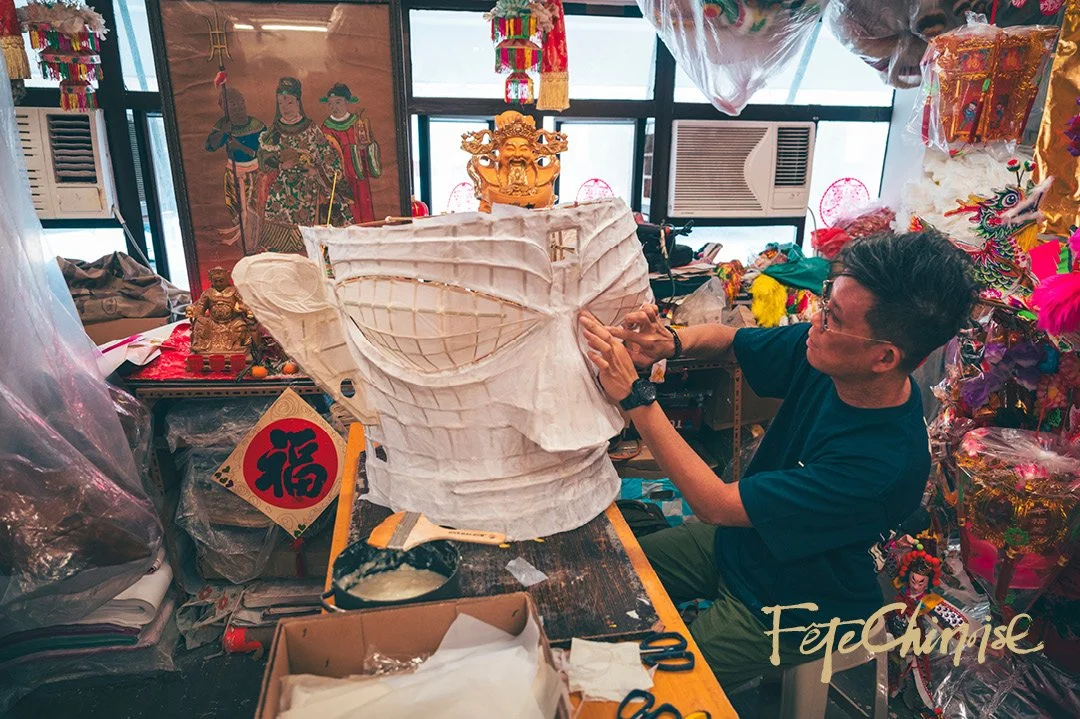

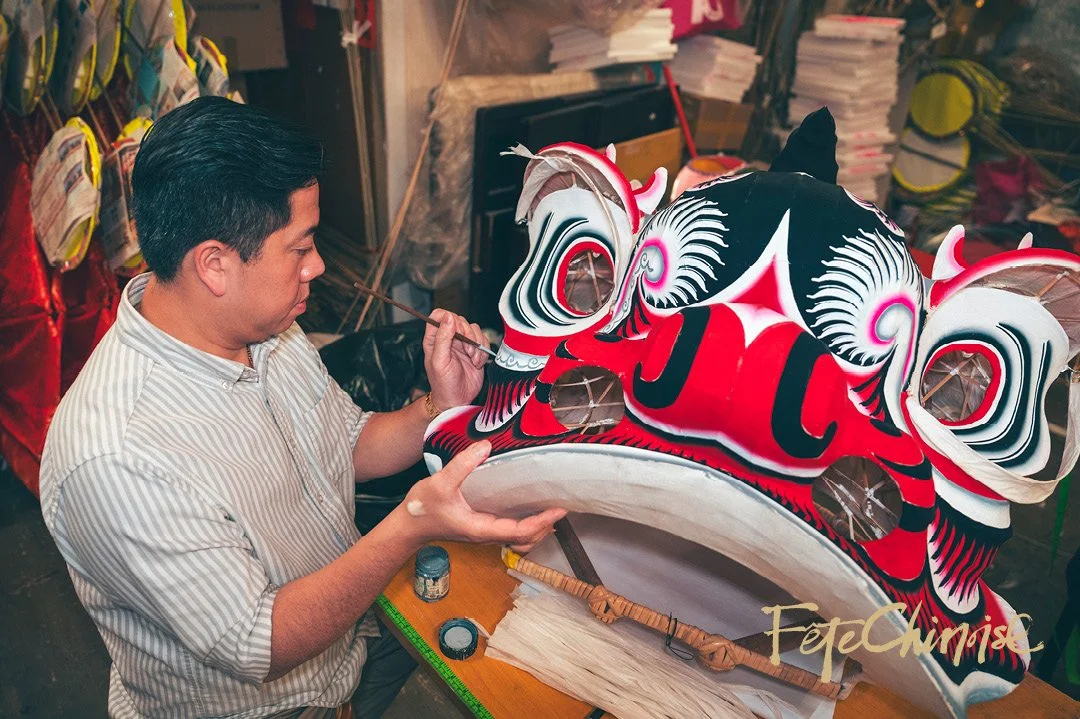





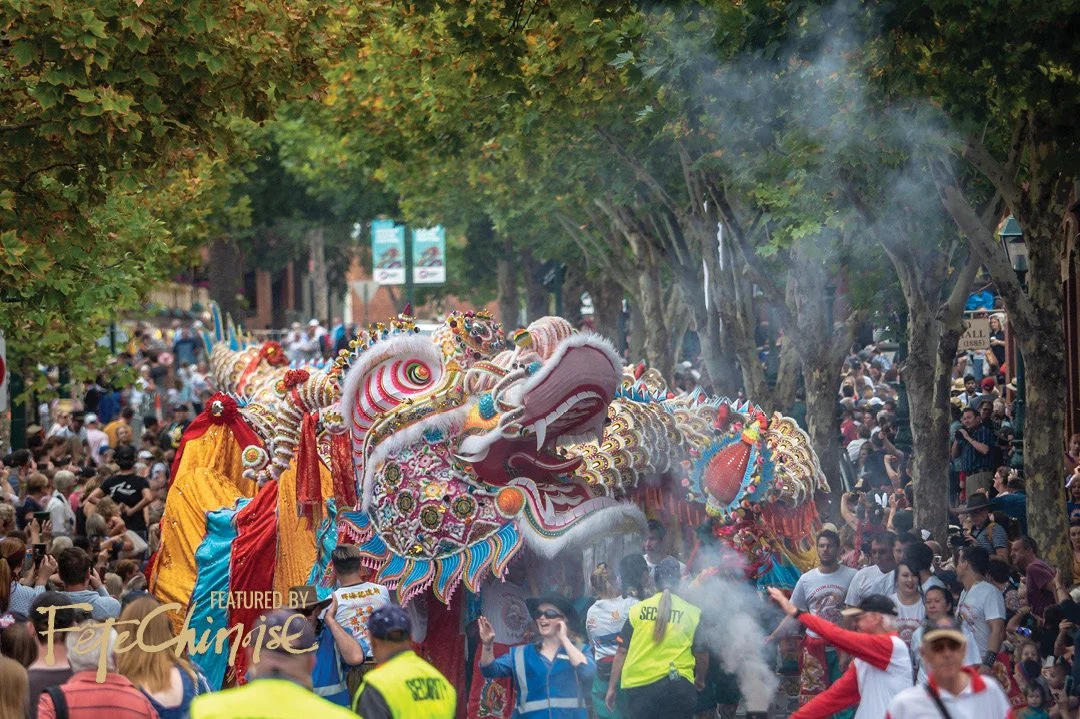




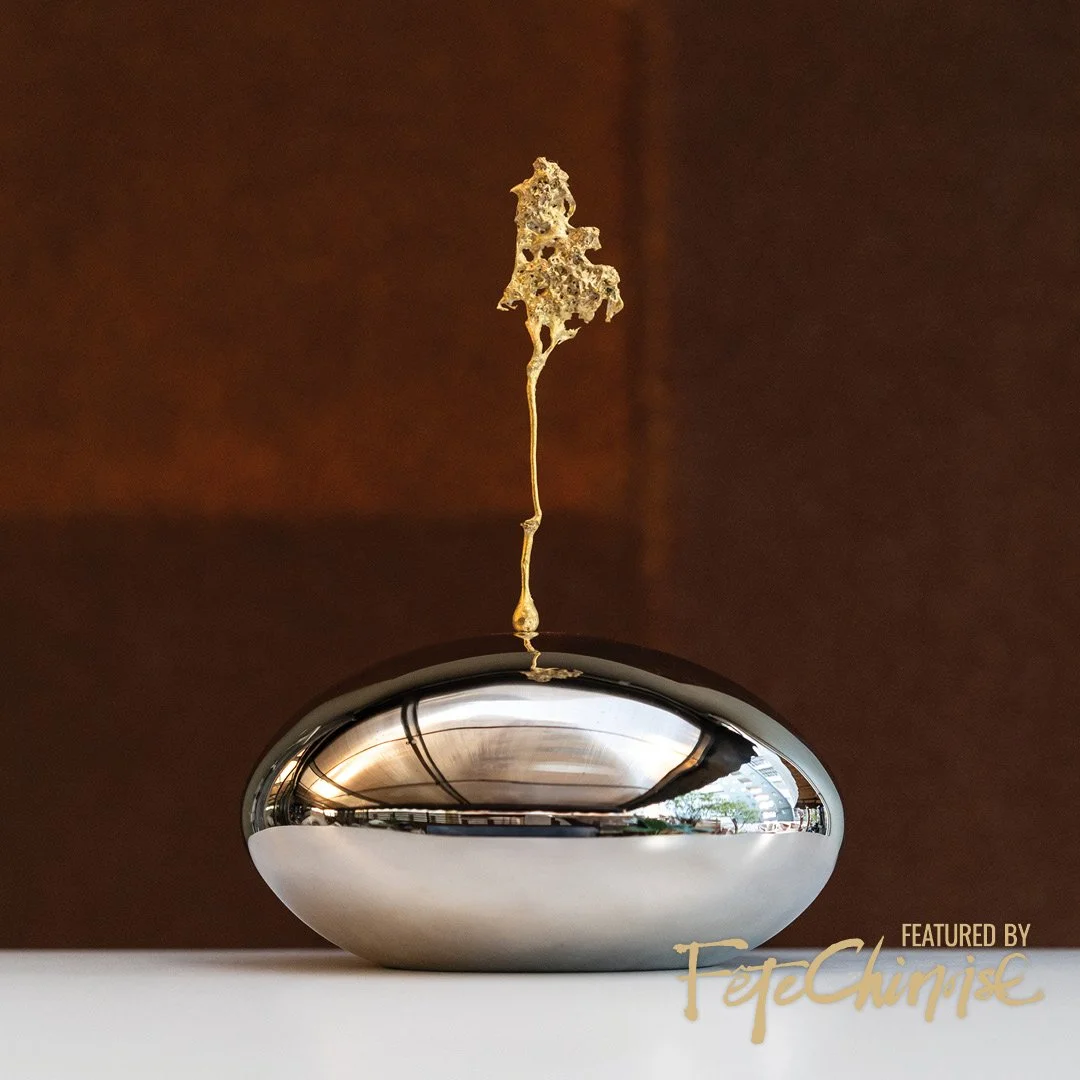
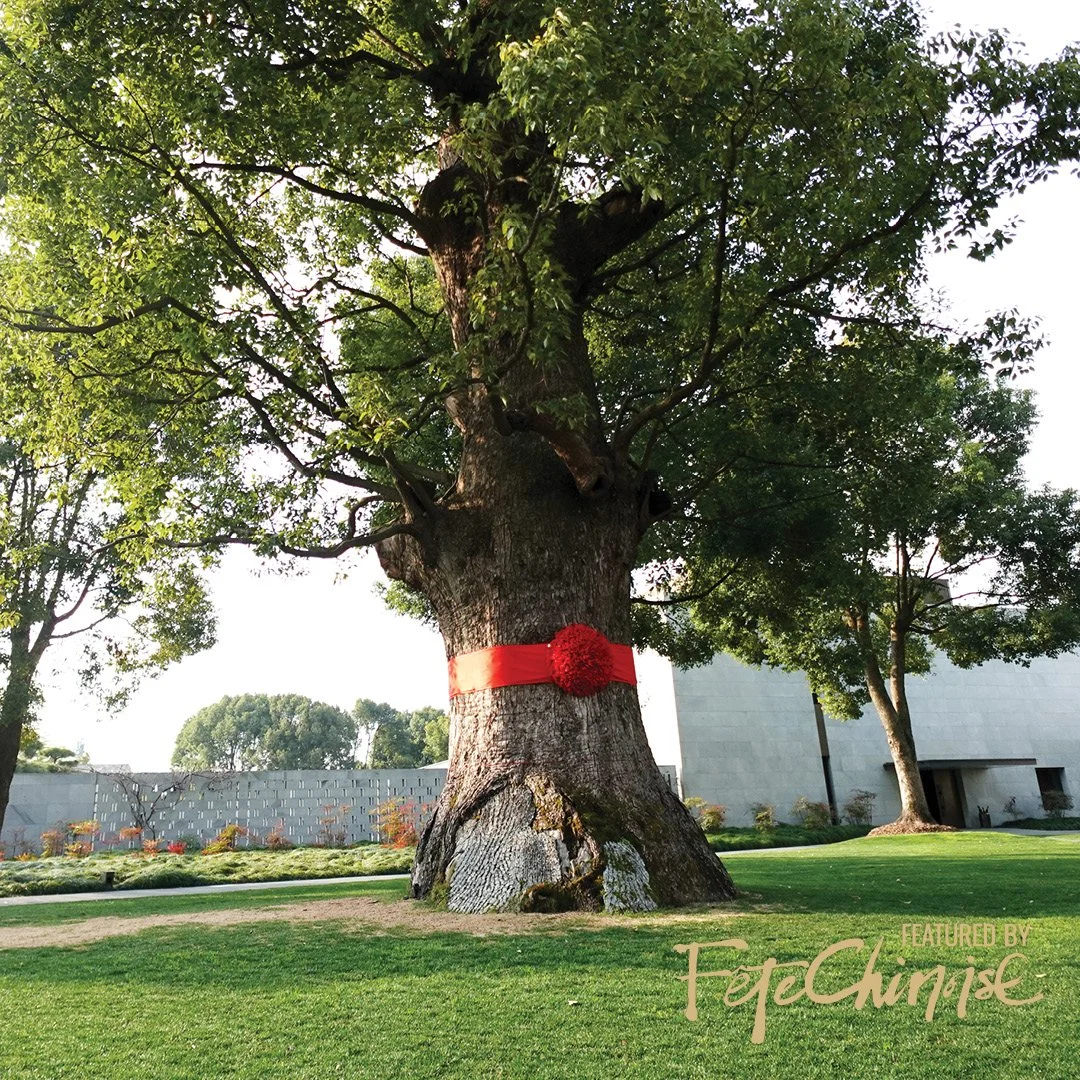







In the skilled hands of Master Hui Ka Hung, paper transforms into vibrant, lifelike creations embodying Hong Kong’s cultural heritage.
Hong Kong is a fast-paced city filled with innovation and potential. Among its towering skyscrapers are streets alive with people rushing to their next destination. Beyond the urban chaos lie alleys steeped in history and tradition. It is here that artisans preserve Hong Kong’s cultural heritage through traditional skills passed down for generations. Among them is Master Hui Ka Hung, whose workshop, Hung C Lau, has become synonymous with the art of paper craft.